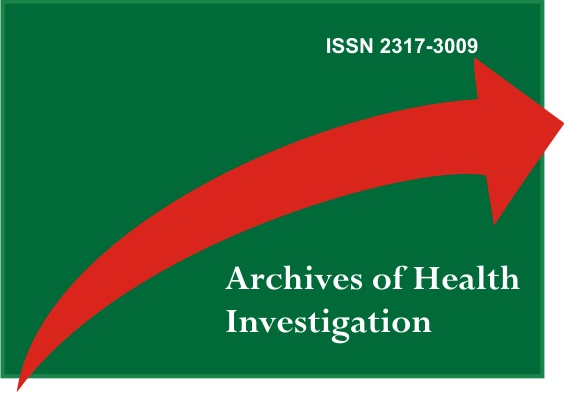Nonprescription Use of Methylphenidate among University Students in the Pharmacy Course: a Barrier to the Rational Use of Drugs
DOI:
https://doi.org/10.21270/archi.v11i3.5570Keywords:
Prescription Drug Misuse, Methylphenidate, Students, PharmacyAbstract
Introduction: Methylphenidate is currently the most used psychostimulant in the world. Healthy people, mainly students, use methylphenidate to improve concentration, attention, and academic performance or for recreational purposes, without a prescription. Objective: Evaluate the nonprescription use of methylphenidate among university students in the pharmacy course at a private college in the city of Natal-RN, as well as to determine the main reasons for use, forms of acquisition and possible adverse effects. Materials and Methods: This is a cross-sectional, quantitative, descriptive, and observational study. The instrument used for gathering data was a standar questionnaire, applied by the researchers between the months of September and November 2019. Results: 136 volunteer students participated in the research, of which 58% said they had already used some psychostimulants during graduation. The prevalence of methylphenidate consumption for neuro-improvement by students was 7.35% of the population studied, being mostly male. Methylphenidate consumption was higher in the population aged 19 to 29 years (10.44%). The most cited form of acquisition was through friends. The data found showed a prevalence of the misuse and irrational use of methylphenidate by students of the pharmacy course, since there was no medical prescription for use. Conclusion: Despite the restricted population studied, this work serves as an incentive for further studies, and thus age as a means of drawing preventive and educational measures to reduce the practice of self-medication.
Downloads
References
Praxedes MS, Filho GFS. O uso de metilfenidato entre estudantes universitários no Brasil: uma revisão sistemática. Rev. Ciênc. Saúde Nova Esperança. João Pessoa-PB. 2021;19(1):39-49.
Leonard BE, McCartan D, White J, King DJ. Methylphenidate: a review of its neuropharmacological, neuropsychological and adverse clinical effects. Human Phychopharmacology Clin Exp.2004;19:151-80.
Domitrovic N, Caliman LV. As controvérsias sócio-históricas das práticas farmacológicas com o metilfenidato Las controversias socio-históricas de las prácticas. 2016;1-10.
Abreu GA et al. Uso de anfetaminas com foco ao metilfenidato. Saúde em Foco. 2021;21-31.
Piper BJ, Ogden CL, Simoyan OM, Chung DY, Caggiano JF, Nichols SD, et al. Trends in use of prescription stimulants in the United States and territories, 2006 to 2016. PLoS One. 2018;13(11):1-15
Ortega F, Barros D, Caliman L, Itaborahy C. A ritalina no Brasil: produções, discursos e práticas. Interface. 2010;14(34):499-510.
Clara A, Coli M. Uso não Prescrito de Metilfenidato entre Estudantes de uma Faculdade de Medicina do Sul de Minas Gerais. Rev Cienc Saúde. 2016;6(3):121-32.
Jain R, Chang CC, Koto M, Geldenhuys A, Nichol R, Joubert G. Non-medical use of methylphenidate among medical students of the University of the Free State. S Afr J Psychiatr. 2017;23:1006.
Cândido RCF, Perini E, Pádua CM de, Junqueira DR. Prevalência e fatores associados ao uso de metilfenidato para neuroaprimoramento farmacológico entre estudantes universitários. Einstein. 2020;18(1): 1-7.
Barbosa LAO, Castro MG, Mesquita LFQ. Prevalência e características do uso de fármacos psicoestimulantes para fins de neuroaprimoramento cognitivo entre estudantes de Medicina. JMHR. 2021;02:01
Gabriele A, Calazans C, França R, Belo C. Prevalência do uso de Metilfenidato por estudantes ingressantes nas Universidades do Município De Sete Lagoas / Mg Lagoas / Mg. RBCV. 2017;5(1):1-26.
Smith ME, Farah MJ. Are prescription stimulants “smart pills”? Psychon Bull Rev. 2011;5(1):717-41.
Korn L, Hassan K, Fainshtein N, Yusov N, Davidovitch N. Non-Medical Use of Prescription Stimulants for Treatment of Attention Disorders by University Students: Characteristics and Associations. Med Sci Monit. 2019;25:3778-87.
Melo JRR, Duarte EC, Moraes MV, Fleck K, Arrais PSD. Automedicação e uso indiscriminado de medicamentos durante a pandemia da COVID-19. Cad Saúde Pública. 2021;37(4):e00053221.
Brant LC, Carvalho TRF. Metilfenidato: medicamento gadget da contemporaneidade. Comunic Saude Educ. 2012;16 (42):623-36.
Kaye S, Darke S. The diversion and misuse of pharmaceutical stimulants: What do we know and why should we care? Addiction. 2012;107(3):467-77.
ANVISA. Agência Nacional de Vigilância Sanitária. Portaria nº 344, de 12 de maio de 1998. (1998). Aprova o Regulamento Técnico sobre substâncias e medicamentos sujeitos a controle especial [Approves the Technical Regulation on substances and medicinal products subject to special control]. 1998. Disponível em http://bvsms.saude.gov.br/bvs/saudelegis/svs/1998/prt0344_12_05_1998_rep.htm
Benjamim CJR, Coelho JLG, Feitosa RA, Santana WJ. Ação da cafeína no sistema nervoso central e na variabilidade da frequência cardíaca. Id on Line Rev.Mult. Psic. 2021;14(54):405-9.
Nascimento EC do, Nascimento E, Silva J de P. Alcohol and amphetamines use among long-distance truck drivers. Rev Saude Publica. 2007;41(2):290-93.
Cruz TCSC, Junior EPDSB, Gama MLM, Maia LCDM, De MJX. Uso não prescrito de metilfenidato entre estudantes de medicina da Universidade Federal da Bahia. Gaz méd Bahia 2011;81(1):3-6
Júnior S, Silva D, Sousa K, Silva D, Vieira MM, Lemos J. Prevalência do uso de metilfenidato entre acadêmicos de medicina do Centro Universitário UNIRG – Tocantins . Rev Cereus. 2016;8(3):172-88.
Silveira Rda R, Lejderman B, Ferreira PE, Rocha GM. Patterns of non-medical use of methylphenidate among 5th and 6th year students in a medical school in southern Brazil. Trends Psychiatry Psychother. 2014;36(2): 101-6.
Fallah G, Moudi S, Hamidia A, Bijani A. Stimulant use in medical students and residents requires more careful attention. Caspian J Intern Med. 2018;9(1):87-91.
Ram S, Hussainy S, Henning M, Jensen M, Russell B. Prevalence of cognitive enhancer use among New Zealand tertiary students. Drug Alcohol Rev. 2016;35(3):345-51.
Terra e Souza LH, et al. Automedicação versus automedicação responsável: uma análise em três escolas de Alfenas-MG. Rev Bras. Odontol. 2010;67(1):8-12.
Finger G, Rodrigues E, Falavigna A. Use of methylphenidate among medical students: a systematic review. Rev Assoc Med Bras. 2013; 59(3):285-89.
Weyandt LL, Oster DR, Marraccini ME, Behavior H, Gudmundsdottir BG et al. Prescription Stimulant Medication Misuse: Where Are We and Where Do We Go from Here? Exp Clin Psychopharmacol. 2016;24(5):400-14.
Zuvekas SH, Vitiello B. Stimulant Medication Use among U.S. Children: A Twelve-Year Perspective. Am J Psychiatry. 2012;169(2): 160-66.


